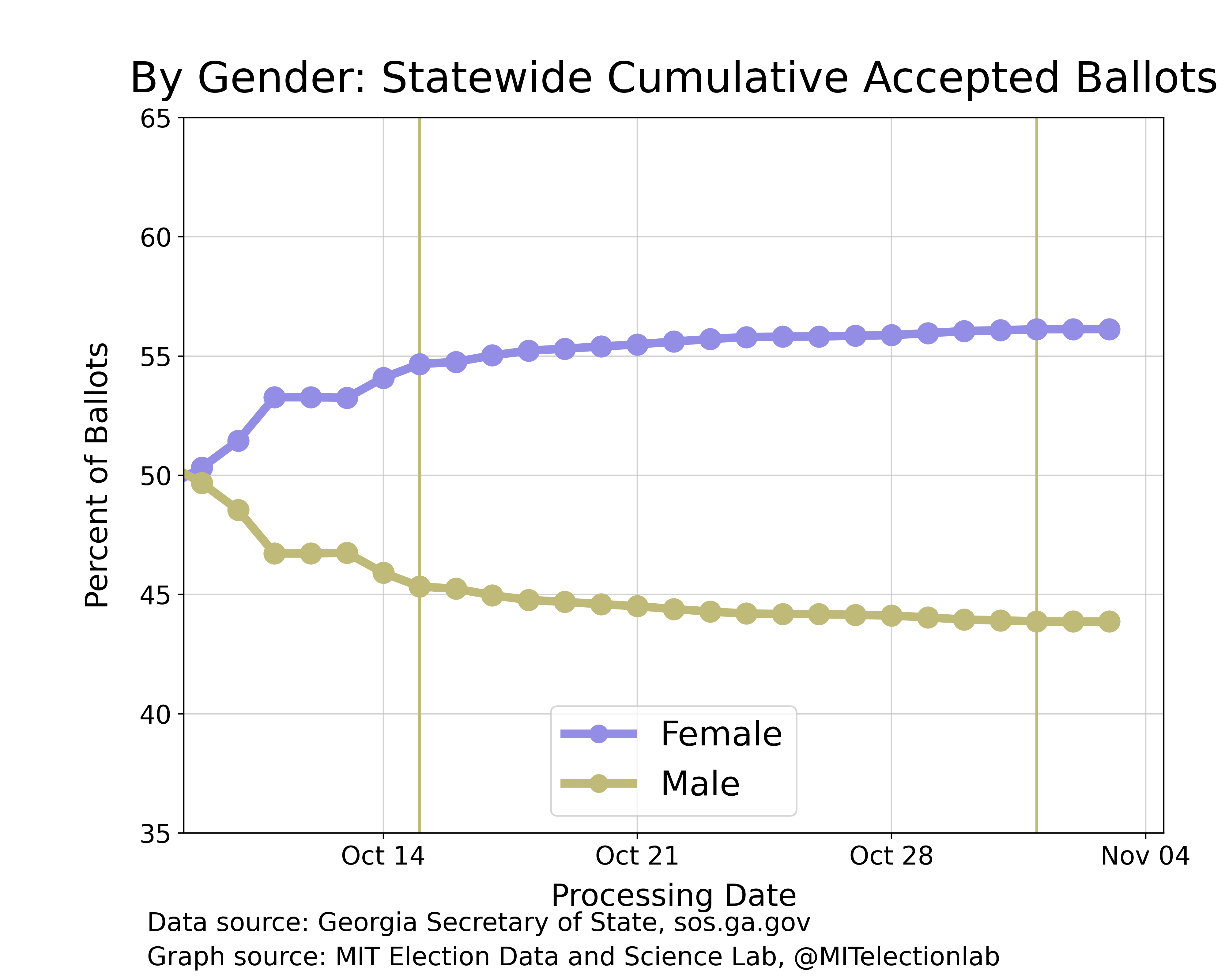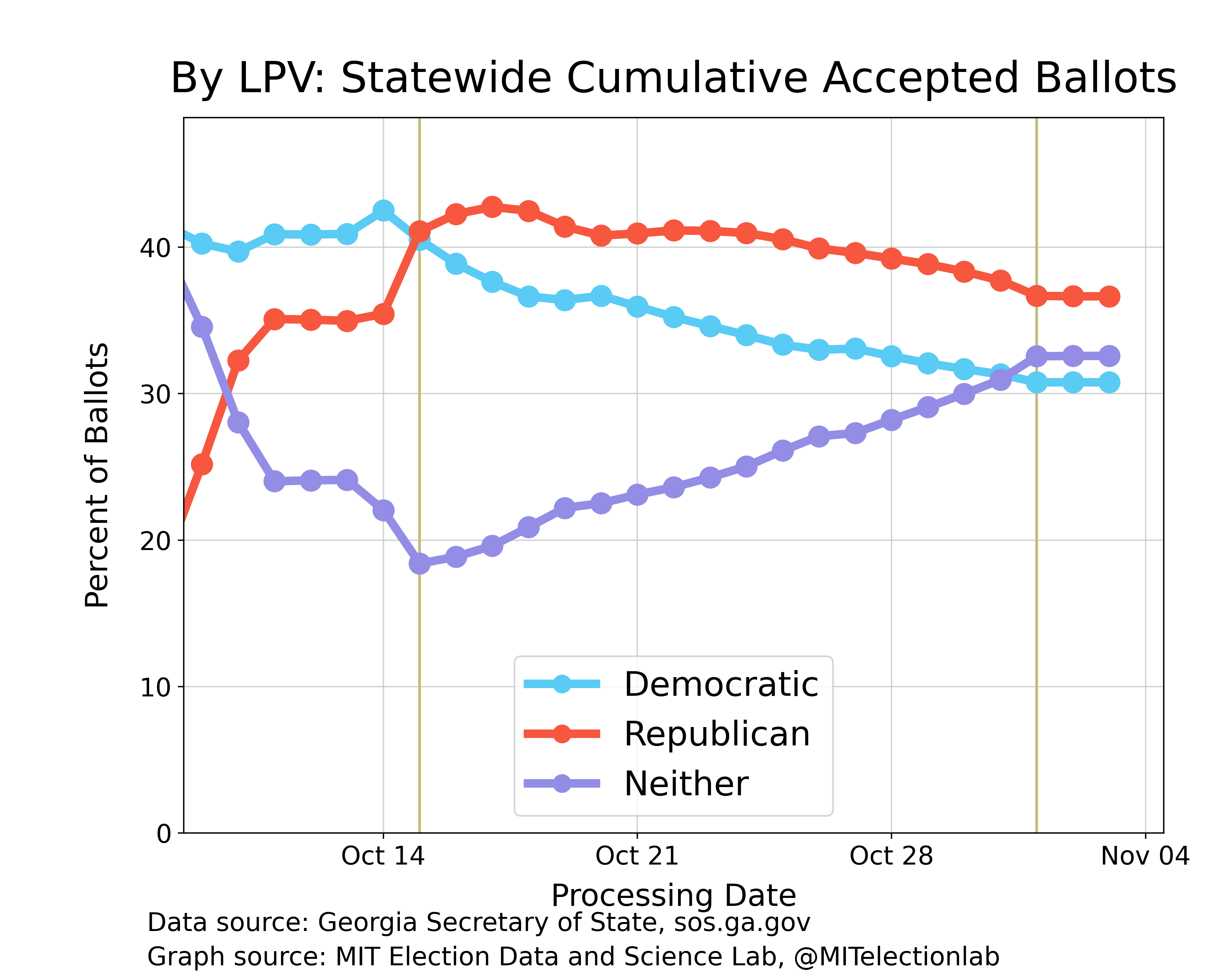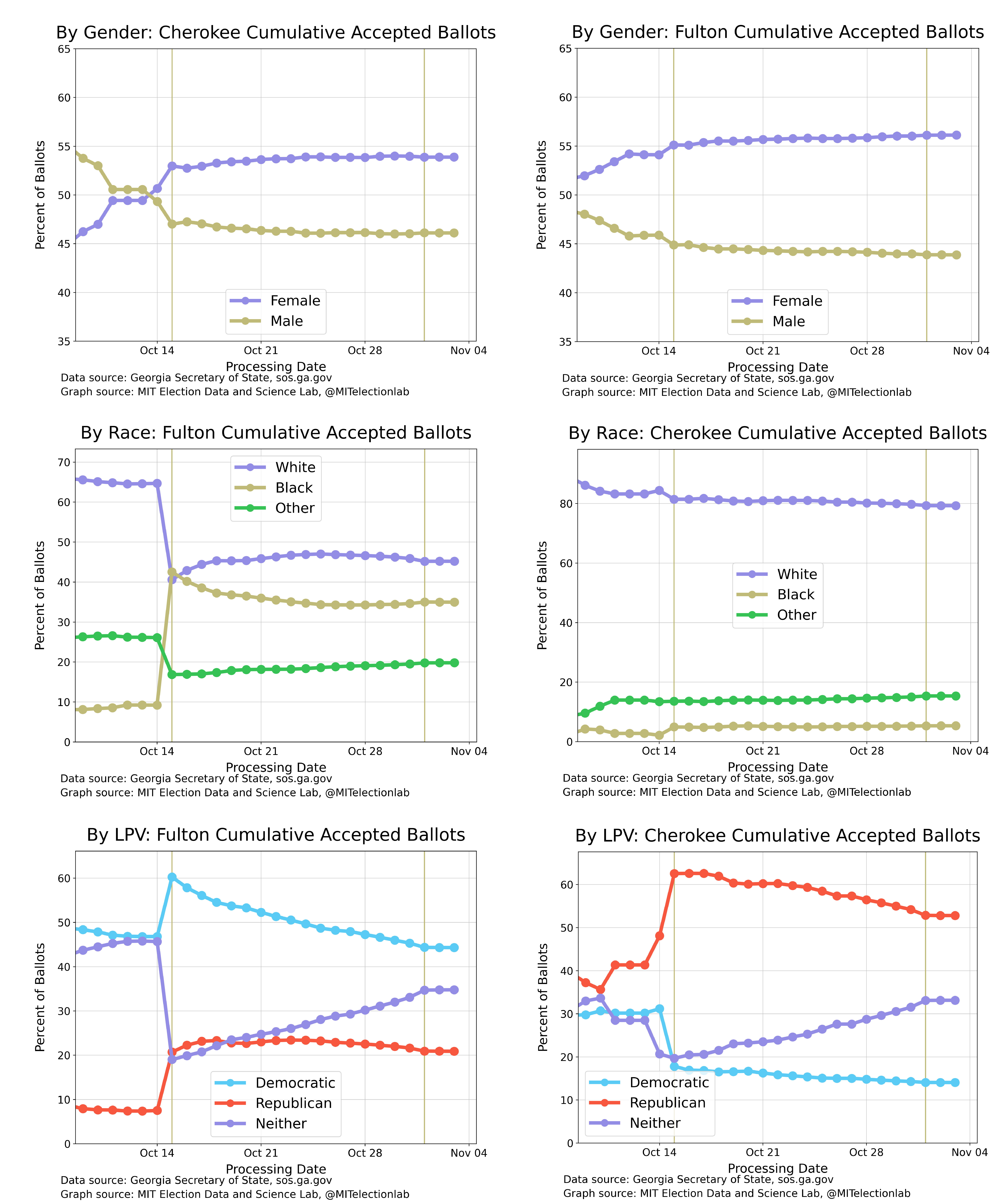Author: Zachary Djanogly Garai
Published: November 5, 2024 (4:36pm ET)
Introduction
Polls in Georgia close at 7 p.m., and results will likely follow not long after. However, just a fraction of the vote will be cast today—all told, over four million ballots were cast and accepted in this pivotal state before Election Day. For comparison, that is around 81% of total votes cast in Georgia’s 2020 election. There is a great deal of administrative data about these ballots, particularly since the Peach State provides demographic data, which we use to analyze the composition of the electorate across Georgia as a whole and in a few notable counties. In this post we examine the demographics of mail and early voters by merging Georgia’s absentee ballot file as of today, available for free from the Secretary of State (see https://mvp.sos.ga.gov/s/voter-absentee-files), with a snapshot of the Georgia voter file, which we purchased from the Georgia Secretary of State.
Figure 1, below, is the first of three plots summarizing demographic trends in the statewide data, showing how the gender composition of the electorate evolved from four weeks before the election until shortly before Election Day. The first gold vertical line, on October 15, marks the first day of early voting. The second gold line, on November 1, marks the final day of the in-person early voting window. Ballots under the Uniformed and Overseas Citizens Absentee Voting Act (UOCAVA) began to be cast in August, and must be received by poll closing time today. As this plot shows, women comprise a 56% majority of the early-voting electorate in Georgia this year. Around 44% of votes were cast by men. As more mail-in ballots were received, the electorate also became slightly more female over time
The Statewide Picture

Figure 2 is similar, depicting the race of voters. For ease of visualization, Hispanic, Asian and Pacific Islander, Indigenous, and other voters were grouped together and compared to white and Black voters. The white share of the electorate dropped notably when a large share of ballots were cast on the first day of early voting, stabilizing at around 58%. Black voters comprise 26% of the electorate, and other Georgians drifted slightly upwards as a share of voters to 16%.

A natural question would be how many of these voters belong to each party. However, the Georgia mail and early voter files do not record party registration per se; the closest information is Last Party Voted (LPV), which records each voter’s partisan primary voting history. Figure 3 groups voters according to LPV. This is not as straightforward to interpret as an analogous plot with party registration data—some in the Republican bucket on this plot may be independents or even Democrats who crossed over to vote in the Republican primary, while others may be Republicans who voted in the Democratic primary. The “neither” category does not necessarily refer to political independents or minor party affiliates; it also may include lower-propensity voters that did not turn out in partisan primaries and those who completed a nonpartisan ballot. Because of updates to the LPV variable, we use a copy of the voter file from June (this could introduce measurement error if voters registered to vote and then voted by mail who are systematically different from the population 5 months ago, however, the vast majority of the voters in the absentee ballot file were also on the June voter file: the match includes 3,988,257 of the 4,123,050 absentee voters).
With these caveats in mind, Figure 3 shows that Democrats comprised a 40% plurality of the mail voting electorate prior to early voting beginning on October 15, when Republicans leapt into a narrow plurality. Republican and Democratic LPV voters dwindled as a share of the electorate over the ensuing two weeks as the proportion of “neither” voters increased to 33% of the electorate. Republicans comprised nearly 37%, and Democrats almost 31%.

Comparing Two Key Counties
The following plots in Figure 4 illustrate analogous trends in two key counties, Fulton County (home to Atlanta) and Cherokee County (in the Atlanta exurbs), which posted the largest net vote margin for Democrats and Republicans in 2020, respectively. In Fulton County, women comprise around 56% of the electorate, like in the state overall, while in Cherokee County, they make up closer to 54%. While Cherokee County’s early and absentee vote was primarily cast by white voters—making up about 80% of the total—the more diverse Fulton County featured a more even split, with nearly 45% of its early and mail voters being white, about 35% being Black, and about 20% belonging to other racial groupings. Breaking these electorates up by LPV presents an especially stark contrast, with the majority of Fulton ballots cast by Democratic LPV voters, compared to a heavy Republican majority in Cherokee. “Neither” voters gained ground as early voting progressed in both counties.

Demographics and Geography
In Figure 5, four maps are shown using these data. Going clockwise, these depict the percent of early and absentee voters in each county who are women, Black, white, and LPV “Neither” voters. A few observations stand out. First, women comprise the majority of the early voting electorate in every county, though they comprise an especially high share in southwestern Georgia and counties in the southeastern Atlanta metropolitan area; the interior southeast of the state and North Georgia have early and absentee electorates that are comparatively male. Second, the racial gaps between Black and white shares of the early and absentee electorates track fairly closely with the state’s racial demographics, and also with typical partisan vote patterns in the state. Third, the plot on the bottom left illustrating the distribution of LPV ‘Neither’ voters shows that they are much more rare throughout interior South Georgia, while they are more common in northeastern Georgia, the Atlanta metropolitan area (and especially diverse Gwinnett County), and smaller urban regions like Columbus, Augusta, and Savannah.

